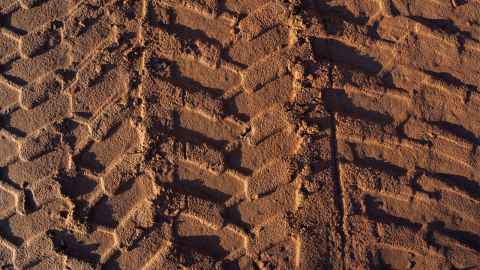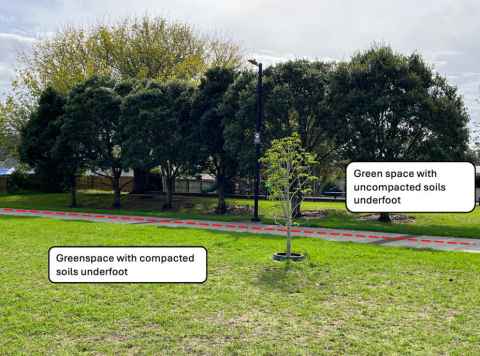Save our soils!
26 September 2025
Commentary: Earthworks compact soil so much that it sucks the air out of it, explains Sue Ira, making it no better than paving at soaking up water in severe weather.

Walk down almost any new Auckland subdivision, and you’ll notice the tidy strips of grass, freshly planted shrubs, and young trees along the berms.
They look green, healthy, and good for the environment but dig a little deeper, literally, and you’ll find that the soil underneath has often been compacted so tightly during construction that its lost its life, its pores, and its sponge-like capacity to absorb water. The result? Increased stormwater flows downstream, thirsty trees above, and a city that looks vegetated but functions more like a green veneer than a living ecosystem.
You may have heard of ‘sponge cities’, especially after the Auckland Anniversary floods and Cyclone Gabrielle in 2023. The idea is simple: cities should act like sponges, soaking up rain and releasing it slowly to reduce flood peaks.
But too often, the focus has been on blue-green engineered stormwater solutions, wetlands, swales and rain gardens, without paying attention to the most fundamental sponge of all: soil. Healthy, uncompacted soils are nature’s quiet way of keeping the water cycle working as it should. They’re what allow big trees to grow, cooling our neighbourhoods, cleaning our air, and making our cities liveable. In short: without healthy soils there are no resilient trees, no urban ngahere (forest).

Compacted soils don’t just increase runoff and flood risk. They also exclude and suffocate roots, reduce soil biodiversity, and limit the growth of large, long-lived trees.
Compaction: the hidden problem underfoot
Our recent investigations across two Auckland catchments – undertaken with other soil and hydrology experts for Auckland Council and funded by the Ministry for the Environment – showed that soils in many new subdivisions, despite being mapped as “permeable”, were, from a hydrological perspective, functioning more like paved surfaces in larger storms. Earthwork practices (cutting, filling, levelling, and driving heavy machinery) compact the soil so much that water can’t infiltrate. A berm that looks green on a map may, in practice, shed rainfall almost as fast as a carpark in intense rainfall.
Compacted soils don’t just increase runoff and flood risk. They also exclude and suffocate roots, reduce soil biodiversity, and limit the growth of large, long-lived trees. Take a pōhutukawa growing in deep, healthy volcanic soil: it will stretch tall, with a broad canopy and enduring resilience. Plant the same tree in a thin layer of fill soil sitting on compacted subsoils, and it struggles: its growth is stunted, its canopy sparse, and its health noticeably poorer. The irony is that while we talk about planting thousands of new urban trees, we often don’t give them the soils they need to thrive.
Why soils matter for urban life
If soils are treated as just something to build on or cover with grass, we miss their real value.
Healthy soils:
- function as sponges, storing rainfall and releasing it slowly
- support tall vegetation that intercepts rain and pumps water back into the atmosphere
- reduce downstream peaks flows; and
- provide the rooting depth for the large canopy trees that define great urban parks and streets: imagine Auckland’s parks and streets lined with majestic pōhutukawa, puriri or totara in the way New York’s Central Park and avenues are graced with grand old oaks.
Healthy soils do matter: our modelling showed that protecting and restoring soils can significantly reduce runoff volumes and peak flood flows. No concrete pipe can match the performance of quality dirt.
Towards ‘soil-aware cities’
We need to flip our perspective. Soils aren’t an afterthought in urban design, they’re infrastructure. A ‘soil-aware city’ is one that treats soils as critical assets, alongside pipes, roads, and parks. That means:
protecting naturally well-drained soils during development
requiring deeper, uncompacted sponge layers beneath road berms, reserves and ‘front yards’
regulating topsoil and subsoil depths, not just surface planting; and
designing with vegetation and soils together, so that tree canopy and sponge soils work as one system – trees help keep soils alive, their roots reinforcing the ground while their canopies draw out moisture between rains
It also means shifting the way we model and plan stormwater. Standard tools used by councils underestimate runoff from compacted soils, giving us a false sense of security. Updating those models to reflect the reality beneath our feet is essential for future flood resilience.
Making dirt real again
At its heart, the message is simple: make dirt more like real dirt again. That means soils that breathe, that teem with microbes, worms and roots, which soak up rain and that give our trees the space to grow tall. We don’t need to invent new technology, we need to stop spoiling the sponge that’s already there and repair it where it has been lost.
From beneath the ground: a call to action
Floods are costly and traumatic. Heatwaves make our neighbourhoods unbearable. Tree canopy targets are easy to promise but hard to achieve if trees die young, don’t thrive or reach their potential. All of these issues connect back to soils. If we want resilient, green, alive, and liveable cities, we need to start thinking beneath the surface.
Planners, engineers, developers, and residents all have a role to play. A ‘soil-aware city’ isn’t just about flood protection, it’s about building places where nature, infrastructure, and communities thrive together. So, next time you’re walking after heavy rain, look down and imagine what could be: soils that breathe, trees that flourish, and cities that are resilient to storms. That’s not a pipe dream – it’s nature. Building soil-aware cities is how we get there, and it starts with the earth beneath our feet.
Sue Ira is an industry expert in water-sensitive design and named Water NZ’s Stormwater Professional of the Year in 2025. She is undertaking a PhD in the Faculty of Engineering and Design.
This article reflects the opinion of the author and not necessarily the views of Waipapa Taumata Rau University of Auckland.
This article was first published on Newsroom, The construction problem beneath our feet, 26 September, 2025.
Media contact
Margo White I Research communications editor
Mob 021 926 408
Email margo.white@auckland.ac.nz